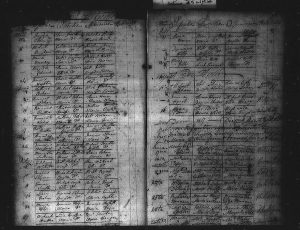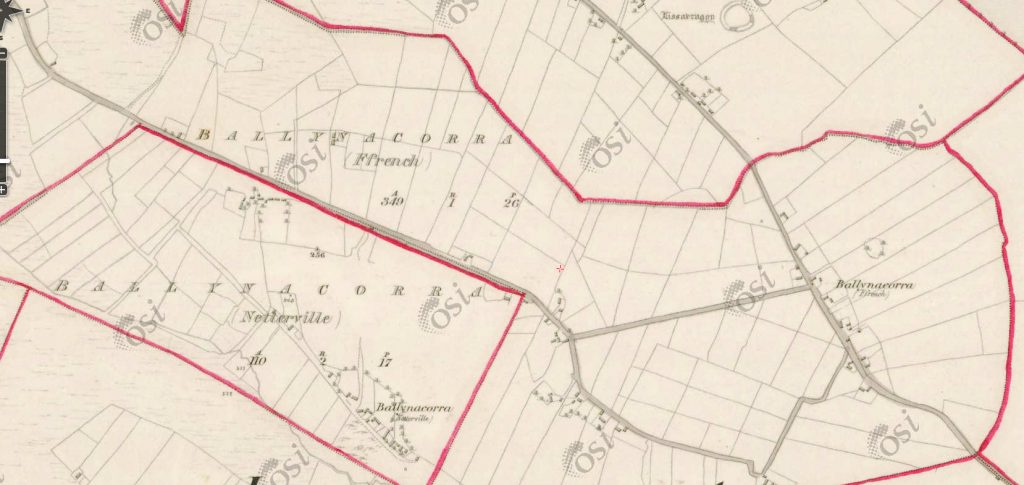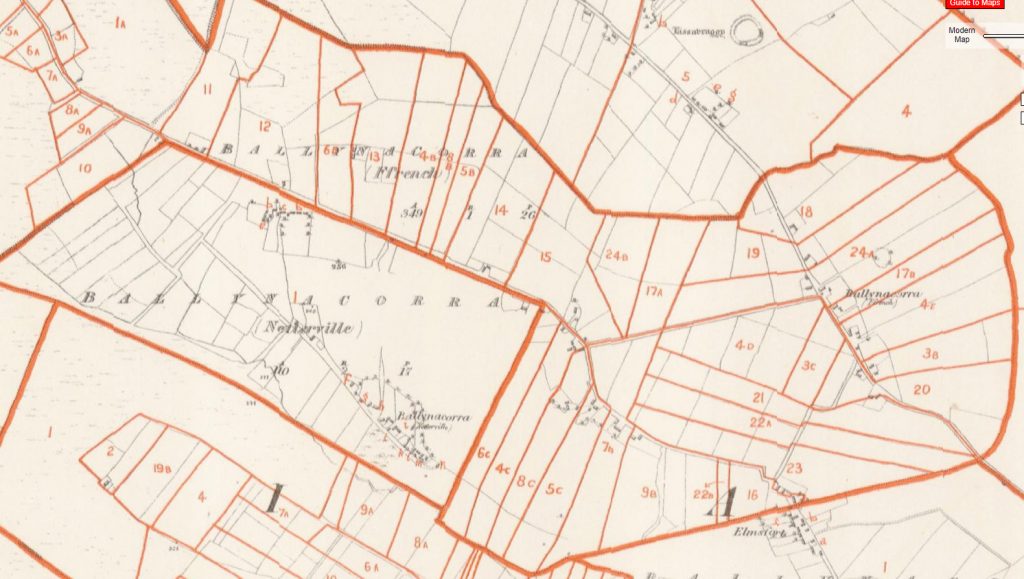No matter where in the world your ancestors came from, genealogy eventually shades off into local history. Because of the destruction of so many records in 1922, in Ireland we reach that point much sooner than most other places. I recently reached it myself.

The problem was to interpret records from an early baptismal register from Killian parish in east Galway. Over the first three decades of the 19th century, dozens of families of the same name were recording baptisms, using and reusing a tiny number of forenames. To cap it all, many of the placenames were not listed in any reference sources.
On examining property records and maps, it emerged that there were actually multiple small rundale villages spread over three townlands. Rundale was a tradition of land sharing very close to medieval European practices, which lasted in Ireland up to the mid 19th century and beyond. Small strips of land were co-operatively managed by extended groups of up to 20 or so households, and periodically redistributed. It was deeply uneconomic and loathed by landlords, but the people involved led an intensely rich communal life, with a wealth of traditions, musical, verbal, folkloric, culinary.

Looking at the 1830s map of these mini-villages, some things became clearer. At last I understood the extended family’s weird long-standing attachment to an apparently nondescript patch of East Galway.
It also became clear that I was never going to be able to sort out one family from another with baptismal records, or indeed ever. My idea of what makes up a family just didn’t apply. Looking at the villages on the map, with their tight nets of in-facing houses, vegetable gardens and outlying fields, I could see these people working, dancing, telling stories, intermarrying generation after generation, with intermingling lives that did not have the boundaries that I take for granted.

I’m pretty sure I’ll never uncover the names of the direct generations before 1800. But there’s plenty of compensation in the vivid sense how they lived.
This is so true and it is the case all over Ireland. My own family operated in a Rundale system here in East County Clare. It is impossible to try to separate some of the branches as they are all so connected and not just with the same first names used in every generation, but also the field system. It goes to show how closely local history and genealogy are intertwined in trying to discovering more about families in the early 19th centuries.
It’s hard to explain what ‘family’ once meant to family and friends today. To most people I know, it means nuclear family. I just can’t seem to convince them of the wide network of people once included in the family, long after immigration, never mind in Ireland. Reading your post today, with its vivid examples and maps, is reassuring. If you can’t sort out all these folks, I’m going to stop worrying that I can’t either.
Good to know. I’m going to Ireland in September and plan to look for church graveyards and cemeteries where my ancestors lived. I may be overwhelmed and totally baffled.
I, too, have recently realized that I will not find exactly where my great grandmother was born but have narrowed it down to two townships where many of her extended family lived. I’m fairly sure she walked there somewhere and that is good enough for me.
First of all, thank you, Mr. Grenham. Every post is enlightening and enjoyable. i always learn something. Now for my question – what is your understanding of the relationships within a townland? I found my family – amazingly – on the 1821 census. It’s a small townland in Cavan, and I’ve wondered if the surrounding families were likely relations. (With the exception of the “big house” family of Nixons that owned the land and the tenants, of course.)
My grandfather (b 1894, d 1985) had a very strong sense of this, he called it goilte (excuse the spelling as I have limited irish). He always said how important it was to know who was your kin and he used rhyme off long lists of names and nicknames, if only I had recorded them in some way, but as a teenager you think he will be there forever with his old men cousins to rhyme it off like a decade of the rosary. I didn’t write it, I didn’t learn it. It is lost. Sometimes I read a baptism in the parish ŕecords or someone mentions a name on a grave and I hear that name reaching out from the memory of the litany of my grandfather and I know that they are goilte. I may never know how, but I know.
Hey it wouldn’t be any fun if it was easy! The best source are the local old relatives and use the records to check and confirm. Having said that, I got back a good deal further using the land records, with the assumption that land passed within families. Eugene OBrien (son of Lohan)
Wow, this is fascinating – thank you! It sounds like you are describing my own recent research into my east Galway ancestors & their kin. 1,001 Hugh Reillys! Loads of Coens & Heads & Earlys, oh my.
Beautifully written and a great explantation – as always – thank you
Yep, and the remarkable thing is how the rundale system persisted when they emigrated. My ancesters formed a family group in New Orleans that encompassd all aspects of their lives. They attended the same churches, the same schools and later as adults they participated in the same charities and the same Confederate army. They were always together.